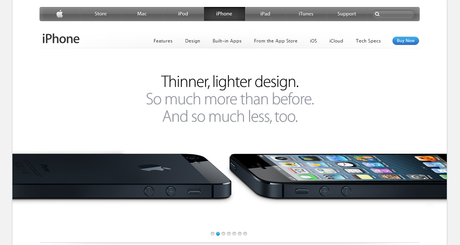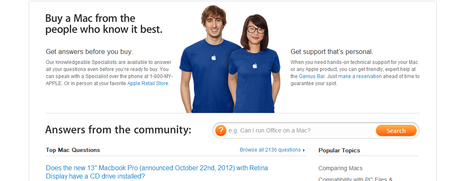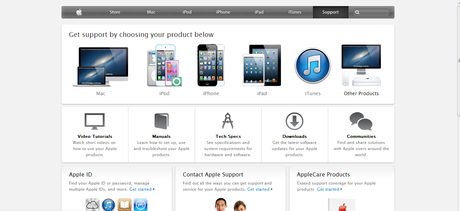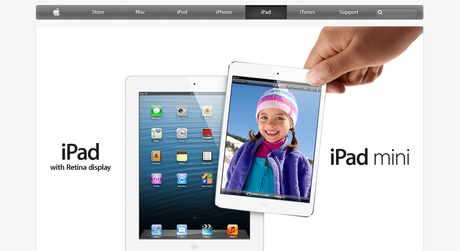Apple is the global giant in eCommerce.
Consumers of Apple products are dedicated, loyal followers, to say the least. You will find them lining up for days to be the first to get a new product, engraving a product to give to a loved one, or even spending hours of a day off in a technology store.
Is it a store? Or is it a lifestyle, with its own dogma? And how does a multinational maker of technology devices evoke such an emotional bond with customers?
As a retailer, your ecommerce store may not be the giant that Apple is, but you can learn from the retail details that Apple uses.
In this article, we want to show some of the small stuff Apple does to make its indoctrinated consumers coming back for more.
7 Tactics retailers can learn from Apple:
- Make your online store easy to navigate.
- Keep choices to a minimum.
- Build relationships with your customers, even online.
- Make sure support is always available and accessible.
- Personalize the shopping experience.
- Segregate your social platforms if you have multiple markets.
- Inform and teach your customers to create loyalty.
1. Make your online store easy to navigate.
A signature of Apple is that their products are user friendly and easy.
Their online store is extremely user friendly and easy to navigate too.
The online store is simple, has the nearly trademarked white space, and clearly defines the five major products Apple sells.
Product headers are easy to see and navigate through.

(source: screenshot of www.apple.com/iphone )
If a consumer is looking for a phone, for example, the product specs are simply laid out and easy to touch or click on, as the customer navigates through the buying process.
At all times, the “Buy Now” button (in blue) is available for the prospective buyer.
Once in the advanced sales funnel process, the purchaser is directed to very visual choices, making the options very clear and extremely easy to navigate.
If the consumer changes an item, the site easily accommodates this.
The consumer sees none of the highly sophisticated backend coding, they only see the very easy solutions to making a purchase.
What can retailers learn from this?
- Create a visually pleasing online store and showcase your products with your consumer in mind.
- Make your sales funnel easy to start on your site. Create distinct “buy” buttons.
- Keep your products sorted, with distinct navigation buttons.
- If possible, allow for changes along the sales process without causing problems for your customer.
2. Keep choices to a minimum.
Research shows that consumers buy when they have fewer choices. Too many decisions leave the customer paralyzed in purchasing. Keep the choices uncluttered, and limit the choices progressing through a sales funnel.
Apple has hundreds of thousands of products available through its site.
Yet, Apple excels at keeping choices to a minimum.
How?
If you have ever visited the online store, you will see organizational elegance. Each first choice in the product sales funnel is sorted neatly into simple header sections.
 (source: screenshot www.apple.com )
(source: screenshot www.apple.com )
The consumer can easily choose from the 7 sections of interest. When you click one section, you are then directed into further easy to see and and easy to manage choices.
For example, the iPod section is visually segmented into 6 further choices.

(source: screenshot www.apple.com/ipod )
From here, the consumer is given more choices, in a limited amount, to further personalize his or her product of choice.
A consumer is not overwhelmed. It makes for a more pleasant shopping experience. The buyer is likely to purchase again.
What can retailers learn from this?
- If you have many products in your store, bundle them in categories.
- Show your prospective consumer more choices only as they make their way through the sales funnel.
- Let your consumer know you have options, but don’t overwhelm them with too much choice all at once.
3. Build relationships with your customers, even online.
At Apple, a core aspect of its retail training is customer relationships.
“[S]taff isn’t focused on selling stuff, it’s focused on building relationships and trying to make people’s lives better.” (Ron Johnson, Former Senior Vice President of Retail Operations at Apple Inc., in Harvard Business Review)
If you walk into an Apple store, you will see how well this is done. Unlike some tech stores, there are no sales staff hounding you to buy as soon as you step over the entrance threshold. Instead the sales staff tend to let you walk in like it’s your place to be, they encourage you to play with the products, and they are very approachable with any questions you have. They are more than happy to try to solve your problems, and get to know you, rather than just push product on to you.
How does this work online?
The same principles apply.
The eCommerce site is filled with clickable visuals. You are not obliged to buy. But you are welcome to play around with the product.
The site offers a clear, distinct phone number for ‘questions’. And not only that, they personalize it with happy sales staff photographed by taglines of “Get answers before you buy” and “Get support that’s personal”.

(source: screenshot http://store.apple.com/us/browse/home/shop_mac )
Additionally, they have an active community section on the site, where customers can ask and answer Apple related topics directly with other customers.
What can retailers learn from this?
- Customers online are just as valuable to your bottom line as customers who walk in to your bricks and mortar store. Treat them as such.
- Create easy options for your customer to reach you for questions, not just sales and support.
- Create a community for your customers. You can do this in a forum type outlet, like Apple. You can also do this through your social media sites, such as by setting up a common hashtag on Twitter, active posts on Facebook, or unique boards on Pinterest.
4. Support is always available and accessible.
In keeping with Apple’s mantra of solving people’s problems, support at www.apple.com is extremely accessible, and always available.
There are distinct visual options for all the major products. Each leads to an easy to navigate support page with notable topics, resources and contact options.
Downloadable fixes and updates are at the ready.
Manuals and video tutorials are simple to access.
Communities are available to garner support from fellow Apple product users.

(source: screenshot http://www.apple.com/support/ )
Many of the issues a customer might have can likely be self-managed through the site, but a person to contact seems always available, and with a friendly smile.
What can retailers learn from this?
- Make support for your product easily available. A customer who knows you are ready and willing to assist them is likely going to be a happier one.
- Create various options for customer support. For example, keep product manuals on your website.
- If your product is a particularly technical one, but your consumer is not, make your support team seem friendly. For example, show faces of your staff on your support page.
5. Personalize the shopping experience
Apple is all about being a little bit different, and having individualized, personal choices.
The shopping experience online and off is all about you, the customer.
Apple offers a seemingly infinite amount of choice for customizing your product. Not only can you get a variety of accessories for any of your products, they even go so far as to offer personal engravings on some of their tech devices.
The online store creates a very personal feeling, with many of the products shown with human faces, or interesting places.

(source: screenshot http://www.apple.com/ipad/ )
The written content on the site is professional, limited, but very colloquial, and not using the grammar your 3rd grade teacher taught. It’s written in a tone that you would expect from a friend, not the world’s largest corporation.
For example, this is how Apple describes the new iPad with Retina Display:
“The Retina display on iPad makes everything look crisp and lifelike. Text is razor sharp. Colors are vibrant. Photos and videos are rich with detail. All thanks to its 3.1 million pixels — a million more pixels than an HDTV.” (http://www.apple.com/ipad/overview/ )
Products like iTunes and Apple TV offer you your choices, anytime, anywhere, and anyhow you like it.
What can retailers learn from this?
- Offer customized and personalized options for your products. For example, offer gift wrapping services that a customer can choose and personalize.
- Show your face, or the face of staff or customers (if they are willing) on your site.
- Pay attention to the tone of your written content on your site. Are you writing to connect with your customer?
6. Segregate your social platforms if you have multiple markets.
Believe it or not, Apple really doesn’t do a lot in the way of social media. They don’t have to. Even the whiff of a whispered rumor lands Apple products in the headlines, and flying off the shelf.
But even this giant has some social sites. And in keeping with Apples’ clean cuts for defined products, they have multiple, segregated Facebook and Twitter accounts.
They have a Facebook presence for iTunes and for Apps.
They also have Twitter engagement for @iTunesMusic,@AppStore, iTunesTV,@iTunesMovies, @iTunesU,@iBookstore, and @iTunesPodcasts.
They use the social sites to promote new songs, movies, apps, TV, books, educational material, and podcasts.
On their iTunes Facebook, for example, they have the Apple Top Ten charts for songs, apps, movies and TV shows.
Favorite songs are easily shared by fans to friends.
Songs, albums and other products are streamlined to purchase with a click from Facebook to iTunes.

(source: screenshot: www.facebook.com/iTunes )
What can retailers learn from this?
- With multiple products targeting multiple markets, set up specific social platforms to interact with your audience.
- Promote your products, but keep the lifestyle of your consumer in mind, and post about related stuff too.
- Set up a social store on your Facebook page to make it easy for your fans to purchase your wares, and to share this with their friends.
- An easy way to set up a social store is through Wishpond’s All-in-One Marketing Suite.
7. Inform and teach your customers to create loyalty.
Teaching your customers about your products creates loyalty. The more informed a consumer is about your product, the more they feel like they know it well, and the more they will appreciate it.
Apple rules in this domain.
The site has a plethora of cleanly designed videos, and simple how-to’s.
Every tech product has detailed specs, with comparisons to other Apple products.
Manuals and user guides are available for every device.
Easy quick start guides are easy to read and use.
Warranty information is available with a click or touch.
And, if you still need more information, customer service is available through a clearly marked 1-800 number on the site, or at your nearby Apple store.
There is no intimidation factor in asking for information online or offline at Apple.
What can retailers learn from this?
- Educate your customers about your product by having easily accessible information on your site.
- Make simple how-to videos about your products. You can embed these on your online store site, as well as social sites.
- Include specifications about your product, so that the consumer can choose which product is right for them.
Increase traffic and drive up revenue to your own eCommerce store. Try these tips, and let us know your successes.
Written by Krista Bunskoek


COMMENTS ( 2 )
posted on 16 December at 23:05
Excellent post! We will be linking to this great article on our site. Keep up the good writing.
posted on 01 November at 21:17
Excellent post! We will be linking to this great post on our website. Keep up the great writing.